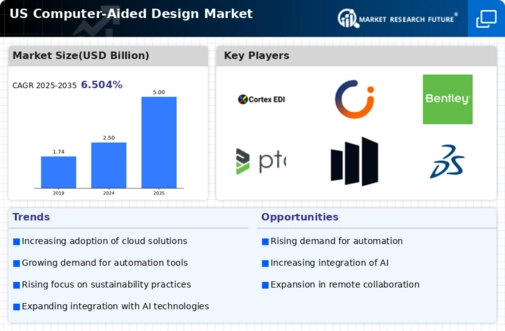The competitive landscape of the US Computer-Aided Design (CAD) Market is characterized by rapid advancements in technology and the increasing need for efficient design solutions across various industries, such as architecture, engineering, and manufacturing. As companies strive to streamline their design processes and enhance productivity, the market has seen an influx of innovative software solutions. The competitive dynamics are shaped by a mix of established players and emerging startups, all vying to capture market share through unique product offerings and strategic partnerships.
Companies are continually investing in research and development to offer cutting-edge features such as simulation, collaboration tools, and cloud-based services, making the CAD space highly competitive and dynamic.
ANSYS has established a formidable presence in the US Computer-Aided Design Market, particularly known for its simulation-based engineering software. Its strengths lie in providing robust tools that enable companies to validate and optimize designs throughout the product development cycle. By integrating advanced simulation capabilities with traditional CAD functionalities, ANSYS enhances design efficiency and reduces time-to-market. The company's commitment to innovation has led to significant improvements in computational capabilities and user experience, attracting a diverse clientele across multiple sectors.
ANSYS frequently engages in strategic partnerships and collaborative ventures that bolster its market position while continuously expanding its geographical footprint within the US.
MicroStation has carved out a significant niche in the US Computer-Aided Design Market, offering a comprehensive suite of design and modeling software solutions aimed primarily at professionals in architecture and engineering. Known for its high-quality outputs and versatility, MicroStation serves a wide array of industries with key products that facilitate both 2D and 3D design workflows. The company's commitment to continuous improvement through regular software updates and the introduction of innovative features has sustained its relevance in a competitive environment.
Furthermore, MicroStation has been active in various mergers and acquisitions, strengthening its market presence and expanding its service capabilities across the US. This proactive approach not only enhances its product offerings but also allows it to leverage synergies that improve operational efficiency and customer satisfaction within the diverse landscape of American architecture and engineering firms.






















Leave a Comment